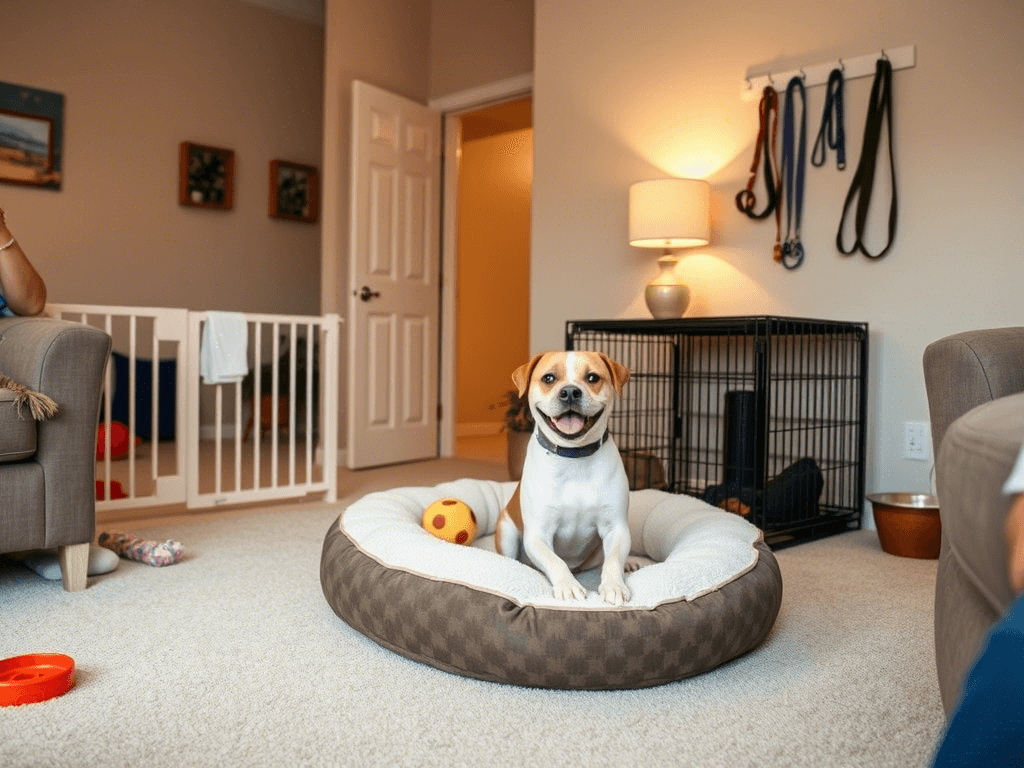How to Prepare Your Home for a Rescue Dog

Bringing a rescue dog home is exciting but requires careful preparation. Before your new companion arrives, make your home inviting and safe. Assemble all essentials in advance, organize a quiet area for the dog to retreat, and remove any hazards. With some forethought and a compassionate attitude, you can set the stage for a smooth transition and a loving bond.
Gather Necessary Supplies
Have all the basic supplies ready before adoption. Stock up on dog food (ideally the same brand the shelter used), sturdy food and water bowls, and a comfortable bed or crate with soft bedding. Pick out a properly fitting collar (with ID tags) and a 4–6-foot leash for walks. Provide a variety of safe toys and chew treats to keep your dog occupied and happy. Other helpful items include grooming tools (brush, nail clippers), waste bags or training pads, and basic cleaning supplies in case of accidents.
- Food & Water Bowls: Stainless steel or ceramic bowls are durable and easy to clean.
- Collar, Leash & Tags: A sturdy collar (with microchip registered) and leash; add ID tags with your contact info.
- Bed/Crate: A secure crate or kennel with a soft bed or blanket gives your dog a personal den.
- Toys & Chews: Have chew toys and interactive toys ready. Safe chewables help redirect biting away from furniture or cords.
- Cleaning Supplies: Enzymatic cleaner, paper towels and trash bags for accidents.
- Baby Gates: Gates or playpens can restrict access to certain rooms or provide a safe zone when you can’t supervise.
Keeping these items on hand will prevent scrambling on day one. Tip: Find out what food the shelter was feeding and start with the same diet to reduce tummy upset.
Create a Safe, Welcoming Space
Provide a calm “den” for your dog with familiar comforts. Set aside a quiet corner or room as your dog’s own territory. Furnish it with the crate or bed you prepared, plus fresh water and a few favorite toys. This space should feel cozy and secure. Place the crate in a low-traffic, comfortable spot (many dogs choose a quiet corner) and line it with soft bedding. When your dog is in this “safe space,” do not disturb them – this gives them a chance to decompress without pressure. Consider using a baby gate to confine the dog to a smaller area until they are fully settled. Over time, as your dog gains confidence, you can gradually allow more freedom.
- Crate or Bed: A crate with bedding becomes a comforting den. If your dog seems scared, keep the door open so they can enter and leave freely.
- Soothing Accessories: Include an unfilled Kong or puzzle toy to keep them busy, and perhaps a worn t-shirt with your scent to reassure them.
- Quiet Corner: Choose a corner away from noisy appliances or constant foot traffic. Covering the crate with a light sheet can enhance the “den” feel.
- Gradual Freedom: Once the dog is eating and resting calmly, you can remove gates and let them explore more of the house.
Giving your rescue dog a private sanctuary helps them feel welcome. They can retreat here if they feel anxious or tired.
Dog-Proof Your Home
Before the dog arrives, eliminate hazards throughout the house. Think of your pet like a curious toddler – anything tempting or dangerous at dog-height should be secured. For example, lock trash bins (dogs can ingest toxic scraps) and keep lids tightly closed. Put away personal items that can be chewed or swallowed (purses, backpacks, shoes). Store human medications, cleaning supplies, and chemicals well above paw level or behind childproof latches.
- Secure Cords and Cables: Puppies love to chew wires, which can cause shocks or fires. Use cord covers or tuck cables out of reach.
- Remove Toxic Foods & Plants: Keep chocolate, grapes, xylitol gums, and other pet-toxic foods off counters. Identify and remove poisonous houseplants (e.g. philodendron, lilies).
- Block Small Hazards: Dogs explore with their mouths. Pick up small objects like batteries, coins, children's toys, and keep them off the floor.
- Fence and Gates: Ensure fences in the yard are secure to prevent escape. Inside, use baby gates to block stairs or rooms with hazards.
- Safe Chew Toys: Provide appropriate chew items (like bones or chew toys) to redirect natural chewing instincts away from your shoes or furniture.
By removing toxins and securing hazards, you protect both your dog and your belongings. For instance, the dog above has a proper bone to chew (rather than chewing your furniture!). Check every room (kitchen, bathroom, office) for dangers before day one. A thorough walk-through prevents accidents and lets you relax as your dog explores safely.
Understand Your Dog’s Emotional Needs
Rescue dogs often carry unknown histories. They may have been abandoned, surrendered, or come from difficult situations. As a result, they can be shy, fearful, or overstimulated initially. It’s crucial to respond with empathy. For example, don’t be alarmed if your dog seems nervous, withdrawn or uninterested in treats at first – this is a common “decompression” phase. During these early days, provide structure, safety and softness. Take cues from your dog: let them approach you rather than crowding them, and speak in a calm, gentle voice.
- Move at Their Pace: “Nothing happens overnight.” Give your dog weeks to adjust. Routine events like feeding or walks should be predictable, but introduce new people or loud noises slowly.
- Be Patient and Compassionate: As the ASPCA notes, your rescue’s past can affect how quickly they settle. They need an understanding, compassionate, and patient owner. If they cower or hide at first, allow them time to feel safe rather than forcing contact.
- Bonding Time: Spend gentle time near them without demands – reading aloud, calmly petting (on their terms), and offering treats as rewards for small brave actions.
- Observe Body Language: Watch for signs of stress (tucked tail, yawning, lip-licking). If your dog seems overwhelmed, give them a break in their safe space.
Remember that every rescue dog is unique. Even dogs of the same breed may react very differently. Approach your new pet with an open mind. With consistent kindness and patience, most dogs learn to relax and bond with their new family over time.
Establish a Consistent Routine
Dogs thrive on predictability. As soon as your dog comes home, set a daily schedule for feeding, potty breaks, walks, playtime and bedtime. Feeding meals at the same times each day (for example, morning and early evening) helps your dog settle their digestion and know what to expect. Take the dog out first thing in the morning and regularly after meals, then again before bed. Schedule play or training sessions at roughly the same times daily. Consistent routines reassure your dog and reduce anxiety.
For example:
- Morning: Wake, bathroom break, breakfast, short walk.
- Midday: Playtime or quiet rest.
- Afternoon/Evening: Bathroom break, dinner, family time/walk.
- Night: Last potty break, then bedtime in crate/bed.
You might also assign family duties: decide who will feed, walk and train the dog so no one is surprised. As the ASPCA advises, drawing up a care schedule helps everyone pitch in (walks, feeding, grooming). A predictable routine will calm your dog and quickly become second nature for you.
Introduce Your Dog to Home and Family
Ease your dog into their new environment and meet everyone gradually. Show them around on leash first: give a slow, guided tour of the rooms and yard so they can sniff and become familiar. Carry treats and praise calm exploration. Let them exit the crate on their own and begin to roam the allowed area. Keep the initial atmosphere low-key – no loud greetings or big parties on day one.
- Meet Family Members Slowly: Introduce one person at a time, in a quiet room. Ask adults and children to turn sideways and let the dog approach them rather than looming over the dog. Teach kids to pet the dog gently on the side or chest instead of reaching for the top of the head. Stay calm and encouraging.
- Other Pets: If you have other pets, keep them separated at first. After a few days, allow a short, supervised introduction on neutral ground. Keep both dogs on leash, and let them sniff each other at their own pace. Praise and treats should reward relaxed behavior during the meeting.
- One Step at a Time: Don’t rush visits to busy places like dog parks in the first weeks. Slowly expose your dog to new people and environments over time, always watching for comfort level.
After each new introduction, give your dog some quiet downtime in their safe space. Gradually, with each friendly encounter and sniff, they will gain confidence and feel like part of the family.
Plan the First Vet Visit
Schedule a vet checkup within the first few days of bringing your dog home. This visit should include a thorough exam, updating any vaccinations, and a discussion of worming, flea/tick prevention, and diet. Use it as an opportunity to ask questions about your rescue’s health history. As experts advise, getting on the vet’s calendar early (even before you pick up your dog) ensures prompt care.
- Bring Records: If the shelter provided medical records or vaccination history, take them with you.
- Vaccinations & Microchip: The vet can administer any needed shots and check that the microchip is registered to you.
- Questions to Ask: Inquire about diet recommendations, spay/neuter schedule, dental care, and any observed issues (ear health, weight, mobility).
- Follow-Up: Plan for any booster shots and routine checkups. Good healthcare from the start sets your dog up for a healthy life.
By partnering with your veterinarian early, you give your rescue dog the best start. A healthy dog is a happy dog, so get preventive care (vaccines, deworming) underway right away.
Patience and Positive Reinforcement
Finally, remember that patience and kindness are your best tools. Rescue dogs, especially those with past trauma, need reassurance. Celebrate small victories and use rewards (treats, praise, petting) to reinforce good behavior. As one trainer notes, positive reinforcement focuses on “strengthening the behavior we want to see” by adding something the dog likes, rather than punishing mistakes. This approach builds trust and makes learning a fun, bonding experience for your dog.
- Reward Good Behavior: Whenever your dog does something desirable (going potty outside, sitting calmly, coming when called), immediately praise them and offer a tasty treat. This makes them more likely to repeat that behavior.
- Avoid Harsh Punishment: Do not yell at or physically punish your dog for accidents or anxiety. Punishment can increase fear and hinder bonding. Instead, calmly remove distractions or redirect their attention.
- Stay Calm: Dogs sense your emotions. If you remain patient and positive, your dog will pick up on that calm energy. (Studies show that a dog’s nervous system mirrors its owner’s emotional state, so your gentle demeanor helps them feel safe.)
- Consistency: Reinforce the same cues and rules every day. If “no jumping on furniture” is a rule, everyone in the family must enforce it consistently. Consistent expectations help your dog understand your household.
Rescuing a dog is a long-term commitment. With each praise and patient moment, you show your dog that they are safe and loved. Over time, this positive reinforcement will help even a wary rescue dog blossom into a confident, happy member of your family.
Good luck and congratulations on giving a rescue dog a second chance. With preparation, patience, and love, you’ll help them adjust smoothly to their new home and begin a wonderful life together.
Sources: Expert pet adoption and care guides (ASPCA, PreventiveVet, Alliance for Therapy Dogs, etc.) were consulted to compile these steps.
